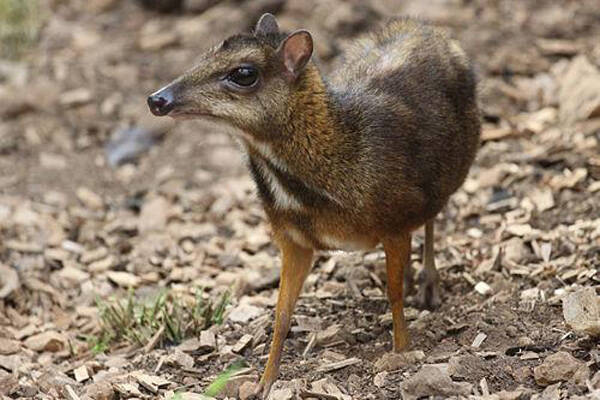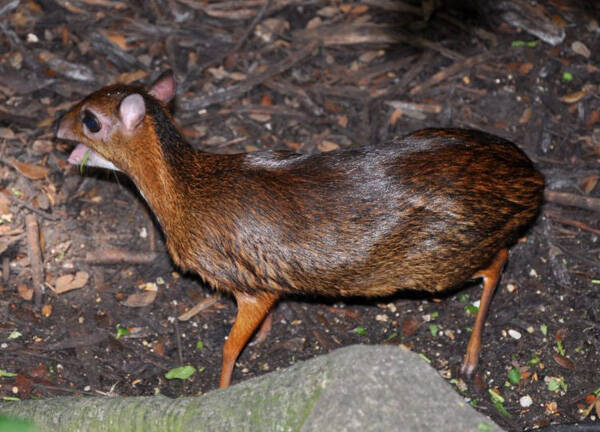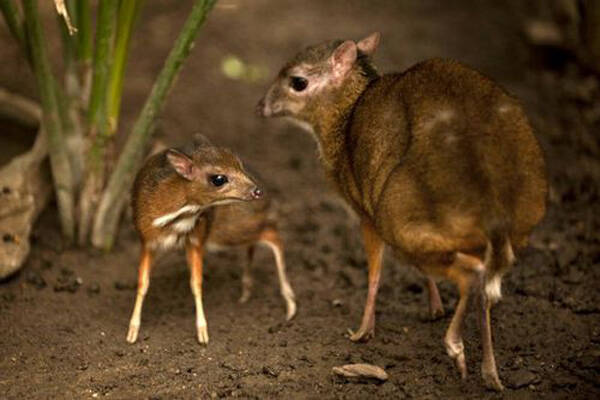Tragulus javanicus
IUCN
LCBasic Information
Scientific classification
- name:Tragulus javanicus
- Scientific Name:Tragulus javanicus,Javan Chevrotain、Java Mousedeer、Javan Mousedeer、Kanchil、Lesser Mouse Deer, Chevrotain de Java、Petit tragul malais
- Outline:Ungulata
- Family:Artiodactyls Tragopanidae Tragopan
Vital signs
- length:46-56cm
- Weight:1-3kg
- lifetime:About 12 years
Feature
One of the smallest ungulates
Distribution and Habitat
The Javan mouse deer is endemic to the Indonesian island of Java; presence is uncertain in Bali.
Restricted to forests of Java and several surrounding islands. Altitude ranges from sea level to 1600 m. Found in overgrown primary and secondary forests of Southeast Asia, the species seems to prefer areas with dense undergrowth, often around rocks, hollow trees and dense vegetation near water.
Appearance
The Javan mouse deer is very similar to the lesser mouse deer and is one of the smallest ungulates, weighing 1-3 kg, with a body length of 46-56 cm and a tail length of 5 cm. It has a triangular head and a rounded body, which is elevated at the rear, with a rounded back and very slender legs. The fur is brown with orange tints. The head and back are darker than the sides. The neck is red like the body, with a distinct black stripe on the nape or gray with no nape stripe, and the underparts including the underside of the tail are white, with a narrow orange stripe down the middle of the abdomen. As with the lesser mouse deer, there is also a series of white vertical markings on the neck, with three white stripes extending from the white underside of the chin to the throat. Adult males have slender, ivory-like upper canines that protrude from one side of the mouth, are several centimeters long, and extend beyond the upper lip; females lack these canines. The Javan mouse deer has no upper
Details
Javan Mousedeer (scientific name: Tragulus javanicus) English Javan Chevrotain, Java Mousedeer, Javan Mousedeer, Kanchil, Lesser Mouse Deer, French Chevrotain de Java, Petit tragul malais, no subspecies.

In the early classification, the Javan mouse deer was classified as a large mouse deer (now called "Tragulus napu") by Chasen in 1940. However, the Javan mouse deer is actually a small mouse deer, and Van Bemmel classified it as a small mouse deer (now called "Tragulus kanchil") in 1949. It was not until 2004 that Meijaard and Groves concluded that the isolated mouse deer on Java Island were clearly distinct from the lesser mouse deer found elsewhere and should be classified as a separate species.
Javan mouse deer live alone and occasionally in groups. They tend to form monogamous family groups. They are very timid and shy and try to remain undetected. They are usually silent, but emit a high-pitched, piercing call when startled. They are active both during the day and at night, and are most active at night, traveling through dense undergrowth using tunnel-like paths to reach their feeding and resting sites, which are usually located in cracks in rocks, hollow trees, and dense vegetation. But they rarely venture into more open habitats. Holes in tree trunks can be used as shelter when resting. They usually move cautiously with a low, slow gait, but if startled at close range, they will raise their tails and flee, revealing their white undersides.
Male Javan mouse deer are territorial. They regularly mark their territory and mates using secretions from the intermandibular glands, a behavior often accompanied by urination or defecation. Males defend themselves and their mates by chasing or slashing opponents with their sharp canine teeth. When threatened, Javan mouse deer will rapidly slap their hooves on the ground at a rate of up to 7 times per second, creating a "drumming" sound. Predators of Javan mouse deer include large birds and large reptiles.

The Javan mouse deer is a ruminant with a three-chambered stomach. As a ruminant, the species uses microorganisms that produce enzymes in the stomach to digest food. In the wild, it is usually herbivorous and folivorous, eating leaves, buds, shrubs, and fruits that fall from trees. In zoos, Javan mouse deer prefer to eat insects as well as leaves and fruits.
Javan mouse deer can breed at any time of the year. Gestation period is usually four and a half months. One calf is born per litter. Pregnancy is possible throughout adulthood and can occur as little as 85-155 minutes after birth. Cubs are born precocious and can stand within 30 minutes of birth. Cubs tend to be "hiders" and the mother will hide them in the concealment of the bush. Cubs are weaned for 10-13 weeks. Sexual maturity is reached at about 5-6 months. Lifespan 12 years.

Java's natural habitats are highly fragmented and have remained so for hundreds of years, reflecting the long-standing high species density. Many protected areas were established during the Dutch colonial period, but from independence until the 1970s they were largely underfunded and neglected. After hosting the World Parks Conference in 1982, the Indonesian government gazetted a large number of national parks and began more structured conservation planning funded by the World Bank and other donors. The emphasis has been mainly on "multi-purpose" national parks, with significant funding for infrastructure, some staff training and staff increases. "Smaller" protected areas such as "game reserves" and "nature reserves" remain understaffed and under-resourced, and have continued to be so. In the 1980s to the mid-1990s, firearms were strictly controlled and the military and police were deterrent and respected. However, a strong culture of caged bird hunting means that hunting, including in the reserves, is mostly for birds and some small game, through various forms of trapping, including snares; the latter most likely includes the Javan mouse deer. There has been some habitat loss in the reserves due to illegal logging, agricultural encroachment and other practices, but the Javan National Parks have remained intact for much of this period. Sociopolitical changes since 1997 have led to less respect for the police and military, and a growing belief that protected areas are resources for the people and therefore could benefit from decentralized management. This policy change risks a "tragedy of the commons", which has indeed led to an increase in destruction and poaching. There is some evidence that species readily use edge and secondary vegetation, meaning that the impacts of forest encroachment will be less severe than if the forests were obligate to primary forests. Furthermore, the Javan mouse deer appeared to have been rare to surveyors working in the early to mid-1990s, when the habitat had been relatively stable since the 1970s or early 1980s. Therefore, for any declines that may have occurred in the 1980s and early to mid-1990s, the population was threatened by hunting and habitat destruction.
Listed in the IUCN Red List of Threatened Species 2014 ver3.1 - Data Deficient (DD).
Protect wildlife and eliminate bushmeat.
Maintaining ecological balance is everyone's responsibility!








